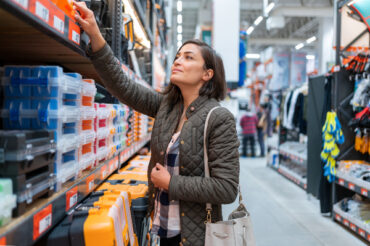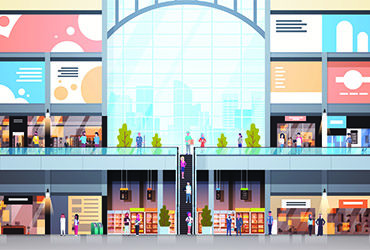Double vision
November 26, 2019The rise of the ‘Digital Twin’ opens up a plethora of opportunities for retailers to create greater efficiency and reduce or even eliminate unnecessary costs within their supply chains. But, what does this cutting-edge technology really mean for retailers of today—and tomorrow?
BY the year 2020, according to a recent report by consulting firm Gartner, there will be more than 20 billion active IoT-connected sensors in operation around the world.
That’s a staggering amount of data—location information, functionality reports, and supply chain updates, combined with everything from customer profiles, to survey data, to demand forecasting. Effectively managing all this data is a relatively new problem within the retail sphere. Fortunately, this new problem already has a relatively old solution. Known as a “Digital Twin”, it promises to alter virtually everything about the way retailers do business— from product design, to manufacture, to supply-chain efficiency, to the in-store experience, and even right into the home.
“You can think of a Digital Twin as a management model to help you make better decisions,” explains Alfonoso Velosa, Gartner’s Vice President of IoT Research. “It’s a virtual representation of a process, a thing, or a person. It could be of the fridges or chillers in a supermarket, or it could be something where you’re keeping track of a person to offer them coupons as they wander through a store. Or it could be about my supply chain; when I get milk on a truck, is the digital model of the milk on that truck kept at 2 degrees centigrade the entire time?”
Essentially a mathematical model of a physical asset, Digital Twins allow retailers to understand products and customers like never before, using accumulated data from multiple sources, including social media, surveys, IoT and RFID data, and realtime operational insights. And while the original model is assembled by data scientists, the Twin can then be integrated with that real-time data, using advanced analytics and AI to paint an ever-evolving picture of its physical double.
“You can think of a Digital Twin as a management model to help you make better decisions.”
ALFONOSO VELOSA
Gartner
“Looking back in time, the innovation was originally used for complex products—rockets, airplanes, automobiles, trucks, trains—stuff like that,” Lars Olson, Digital Products Solution Manager with SAP explains. “Unique, serialized products. But the notion of Digital Twins has really evolved over the past 15 years. It’s since become part of automotive, and even a number of consumer products in the retail space.”
Segments of one
As Olson explains, the technology behind Digital Twins isn’t new; some form of paired system has been used by NASA for decades, and in fact, was responsible for helping bring the illfated Apollo 13 mission back to Earth in the spring of 1970. But, as Veloso adds, it wasn’t until the advent of cloud-based computing and the Internet of Things that the concept became economically viable at a corporate level.
“Back then, you needed a couple hundred PhDs, and you’d be building these hardware and software models,” he notes. “It was cutting edge. But that was back then. Since, things have become faster, better, and cheaper. We’ve continued to improve the process.”
In both 2017 and 2018, Gartner placed Digital Twins among their top 10 technology trends. And by 2020, the company predicts that more than 50 per cent of large-scale manufacturers will have implemented some form of Digital Twin initiative. And, while Gartner predicts more than 20 billion IoT-connected sensors worldwide by 2020, it seems that the retail sector is still a relative newcomer to the concept.
“In retail, it’s definitely still an emerging thing,” Olson says. “It’s happening, and some retailers are more sophisticated than others. Right now, there’s still a pretty big gap between the high end and low end. It’s a conversation we’re having more and more. But it’s been going on in other industries— like manufacturing and aerospace— for nearly twenty years now.”
“Right now, retail is #5, in terms of adoption,” Gartner’s Velosa adds. “This is all still in its very early stages. And the experiments being done in retail are all very practical. It’s being used in internal operations, and the other main thing is using it to interact with customers in a better way.”
From a supply-chain perspective, Digital Twins allow retailers (and in some cases, customers) an unparalleled look at the lifecycle of a product, from manufacture to shelf. Linked POS and back-end systems allow for inventory management at a granular level, often leveraging historical demand statistics to keep the right products on the right shelves at the right time.
“Companies are also using this technology to better understand what to restock at night,” Olson explains. “That saves people having to go and do a physical count—if you can keep track of items as they leave the shelves, then you know exactly what your status is from an inventory perspective.”
One of the most common applications for Digital Twin technology involves energy savings; data gathered by IoT-connected devices like fridges and lighting allows individual devices to regulate their energy consumption based on real-time data and historical demand.
However, this level of segmentation goes further still; some leading retailers have even built Digital Twins of customers themselves —combining social media information with eCommerce data, and in some cases in-store behaviour; through the use of beacon technology and sophisticated computer vision, a consumer’s physical habits can be paired with their digital ones, allowing retailers to create a segment of one, providing tailor-made marketing and promotional materials (when a customer approaches something they might enjoy, for example). This data can even inform things like store layout.
“It’s about trying to understand and create some analytics around how people move through a store,” says Velosa. “You’ve made a Digital Twin of that space, to maximize space and usage. For example, you can analyze how many people are gravitating toward a sale or an end-cap.”
“You’ve got connected devices within a retail environment,” Olson adds. “That could be connected POS systems, or the back-end office and logistics systems—such as the ones companies like Amazon use to move inventory around. The scanning of the barcodes—tracking technology that keeps track of Digital Twins through the complex logistics process. There’s a lot going on behind the scenes. The customer doesn’t really see it happening, but it’s what makes the retail world turn, so to speak.”
Twinners and losers
And thanks to the evolution of IoT, this kind of product management can extend beyond the sale of the product itself.
“It’s about building smart products that are innovating within our homes,” Olson notes. “There are things like IoT-connected showers or thermostats, which is all connected through a digital assistant like Alexa. Now you’ve got a shower you can turn on remotely, you can set the heat to your favourite temperature; these things are connected to your phone, and ultimately, if the consumer allows it, you as a manufacturer can monitor those devices and see how they’re working. That way, you can sell services to that customer base— upgrade and monitor the performance or deploy firmware to improve a product.
And while retailers have yet to leverage the full capabilities of this technology, both Velosa and Olson agree that, as costs come down, Digital Twins will continue to grow in scope and complexity—both within retail, and in adjacent industries like the manufacturing sector. Already, larger companies like SAP, Gartner, Siemens, IBM, and Microsoft are offering Digital Twin solutions to corporate clients of all stripes. Digital Twins have now been created for all manner of assets—from cars, to container ships, to a digital version of the city of Singapore. But, as to whether implementing a Digital Twin strategy is right for every retailer, Velosa and Olson have the same answer: it depends.
“What business objectives do you have that this could help with? It’s about fundamentals. Where do you think you can lower your costs, or drive new or better revenue?”
ALFONOSO VELOSA
Gartner
“What business objectives do you have that this could help with?” Velosa asks. “It’s about fundamentals. Where do you think you can lower your costs, or drive new or better revenue? Start with an objective—something you can experiment with that will give you key performance indicators you can test against.”
“Typically, the barriers to adoption are around data collection,” Olson points out. “What is the Master Data you have from the various areas of your business? Because you need both—the virtual and the physical. With design, it’s the virtual side of things. In planning, it’s just virtual. But in manufacturing and logistics, you have the physical. Same with operations. So, the various systems that make up that Master Data—all the way from design to operations— they need to be tied together. You have to create interfaces between the design system and the manufacturing system, for example. If you’re not on a common platform, you can have integration problems, because synchronizing your Digital Twin data throughout the lifecycle will become extremely difficult.”
“Provided a company has any sort of data infrastructure, and connected systems, then it would be key to help drive internal cost optimization,” Velosa concludes. “You could build something like this—not necessarily cheaply, but we’ve seen these sort of projects pay for themselves within 12 months, with something like energy optimization. With all these things, it takes some time to implement them. There’s a very strong level of interest, because companies are seeing this driving their fundamental business objectives: increasing revenues and reducing costs. It’s as simple as that.”
BY JESSE DONALDSON




